Dwarfed by the vastness of the South American continent, Peru has a vastness of its own. Superimposed on a map of the United States, it would stretch from
Chicago to New York City in the north, and to Miami to the south. With an area of 1,285,216 square kilometres, it is the third largest nation in South America.
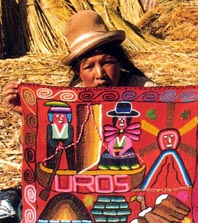 Weaver of tapestries near
Titicaca
Weaver of tapestries near
Titicaca
Half of the population, mostly whites, live along the Pacific coast. The rest of its people are Indians, mainly Quechua and Aymara who are subsistence
farmers in the mountains. For 20,000 years, diverse Indian peoples have made their home in Peru. The 7,700 year old Paloma may be the oldest village in the Americas.
The Incas were ruling from Cuzo when gold and silver lured the Spanish to these distant shores. In 1824, General Simon Bolivar’s military forces ended
Spain’s rule on the continent.
Dominating the country, the range of Andes Mountains rise with stupendous heights to snow fields and glaciers, at 6,768 metres. They wall off the arid
coast where little rain falls. Snowmelt from the Andes feeds rivers that cross the arid coastal plain and supplies irrigation to farmers. The moist eastern slopes of the
Andes tumble to dank, humid, jungle lowlands whose rivers are the highways for transportation.
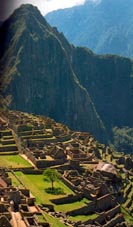 Lost city of the Incas, Machu
Picchu
Lost city of the Incas, Machu
Picchu
Peru lies atop an area where the Pacific Ocean crust slides beneath the continent resulting in severe earthquakes and occasional volcanic eruptions. The
diversity of this country is wondrous.
To the north and south of Lima encroaches one of the earth’s driest deserts. To the west, the country drops into the Pacific. To the east, the abrupt
wall of the Andes rises.
Unlike the coasts of Columbia and northern Ecuador, Peru’s coastal region is parched because of an anomaly called the Humbolt Current, which flows
northward from the Antarctic, working a sea change over virtually everything. Prevailing winds from the south drive surface waters offshore, causing cold water to up well
from the ocean depths. The plankton that permeates these waters attracts vast swarms of anchovies, which in turn draw millions of seabirds. Their droppings over the centuries
have coated offshore islands with guano hundreds of feet think.
 The delicate Andes Llama
The delicate Andes Llama
Lima, Peru’s capital city, whirls around plazas, a pattern set in 1535, during Spanish rule. Today it is a city, much like other major capitals, choked
with traffic and bustling with commerce. The ubiquitous ambulantes, the sidewalk vendors, sell everything from alpaca ponchos and TV antennas to skewers of sliced beef
heart and murky red portions of “iguana blood” which is sold as a tonic to increase strength and endurance. This pushcart army of impoverished hawkers are driven by want
from their ancestral Andean highlands, and drift into the city by the millions. Jobless, barely educated, they take to the streets as vendors, shoeshine boys, tyre-changers,
minstrels, beggars, and when all else fails, pick-pockets and petty thieves.
The upper class neighbourhood of Miraflores is another world. Wide boulevards are flanked by tall buildings and fashionable department stores. Before the
glittering store windows pose lovely, fair-haired Creoles of nearly pure Spanish decent, and stunning mestizas with rich auburn hair and glowing cinnamon complexions. Take a
seat at a sidewalk caf้ and order a cortado, the sweet expresso topped with frothy cream, and watch Lima’s crowds parade along the avenue in the latest styles
from Paris, New York and Madrid. The men stride smartly among them, handsome and imperious, they view the passing beauties with practised eyes. Indian women from the Andean
highlands seem as out of place here as would an extra terrestrial.
 Fishing boats along the coast of
northern Peru
Fishing boats along the coast of
northern Peru
A plane out of the city of Lima will hurdle the snow crests of the Andes and take a visitor over the streaming green Amazonian jungle, which covers more
than half of the country.
The Amazon Indians have long played a part in Peruvian history. Their feats of war are legendary. Unfortunately, Spanish rule and devastating disease wiped
out whole native populations through the ages. During the past decades, transmigration of highland peasants, encouraged by government to settle regions along the Amazon
River, has reduced the habitat of indigenous tribes.
Great rivers of the world, such as the Nile in Egypt, renew their soil by virtue of stream valleys and flood plains. The Amazon jungle has, in contrast,
very poor soils and game animals are diverse, but few and far between. Currently there are some 200,000 native Indians in the Peruvian Amazon, divided into 53 ethnic groups
and 12 different languages.
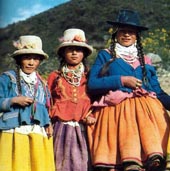 Highland peasants of the Andes
Highland peasants of the Andes
Lake Titicaca is the world’s highest navigable lake - 12,500 feet above sea level. Titicaca is also famous for the floating reed islands constructed by
the Urus and Aymaras Indians. Some of these islands are the size of football fields, replete with villages, schools and playgrounds.
A trip out to these islands can take several hours if one wants to avoid hordes of tourists at the closer ones. Locals pole their way through a maze of
reed-grown channels. Once ‘ashore’ it takes a little time to get one’s sea legs. The reeds go down about six feet, and the spongy surface at the edge is unstable for
the novice. The topmost layer must be renewed once a year, while the bottom most layer simply rots away. From these same reeds, these islanders make their homes, bed mats,
baskets, boats and sails. The even eat them, relishing the celery like lower stalks and the roots.
The mystifying ruin of the sacred city of the Incas, Machu Picchu, was not discovered until 1911 by Professor Hiram Bingham of Yale University. Historians
speculate that this was one of a series of outlying refuges to which the last of the Inca rebels fled after Pizzarro ousted them from their imperial capital at Cuzo, which is
only about 70 miles away (as the condor flies).
Bingham found it mouldering beneath centuries of vegetation. The mystery of the abandoned city lives on today. What happened to these people who had no
knowledge of the wheel, no beasts of burden sturdier than the delicate llama, and who still managed to impose their rule over a domain as far-reaching as that of ancient
Rome?
Peru is certainly one of the most spectacularly beautiful countries in the world. It also ranks among the world’s great centres of ancient civilisation.
The sun worshipping Incas are only the most famous of a long line of highly developed cultures which thrived thousands of years before the arrival of Europeans. Ancient and
mysterious, modern and chaotic, Peru is an adventure which needs time to plan and savour.
 The generous donators gather for a
group photo.
The generous donators gather for a
group photo.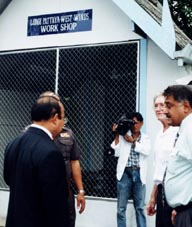 Donations from the Lodge Pattaya
West Winds made it possible to complete construction of the vocational training workshop at the center.
Donations from the Lodge Pattaya
West Winds made it possible to complete construction of the vocational training workshop at the center. Chalit Chatsathien and his
associates donated bedding and food.
Chalit Chatsathien and his
associates donated bedding and food. Rotary Club of Jomtien-Pattaya
president Erika Keller and Rotarians lend a helping hand.
Rotary Club of Jomtien-Pattaya
president Erika Keller and Rotarians lend a helping hand. Pattaya’s own Chi Kung teacher
Patrick Stahl led a local group participating in World Tai Chi-Chi Kung Day in the gardens of the Dusit Resort Pattaya.
Pattaya’s own Chi Kung teacher
Patrick Stahl led a local group participating in World Tai Chi-Chi Kung Day in the gardens of the Dusit Resort Pattaya. Weaver of tapestries near
Titicaca
Weaver of tapestries near
Titicaca Lost city of the Incas, Machu
Picchu
Lost city of the Incas, Machu
Picchu The delicate Andes Llama
The delicate Andes Llama Fishing boats along the coast of
northern Peru
Fishing boats along the coast of
northern Peru Highland peasants of the Andes
Highland peasants of the Andes Andrea and Norbert Kühn of Germany, guests of the Thai Garden Resort, made a
donation of DM 1,400(28,000Baht) to the newly founded Prov. Rotary Club of Taksin-Pattaya to help them with their charity projects.
Andrea and Norbert Kühn of Germany, guests of the Thai Garden Resort, made a
donation of DM 1,400(28,000Baht) to the newly founded Prov. Rotary Club of Taksin-Pattaya to help them with their charity projects.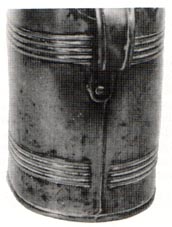 An example of a folded over joint
on a 19th Century watering can
An example of a folded over joint
on a 19th Century watering can Brass jardini่re from 1920s
Brass jardini่re from 1920s